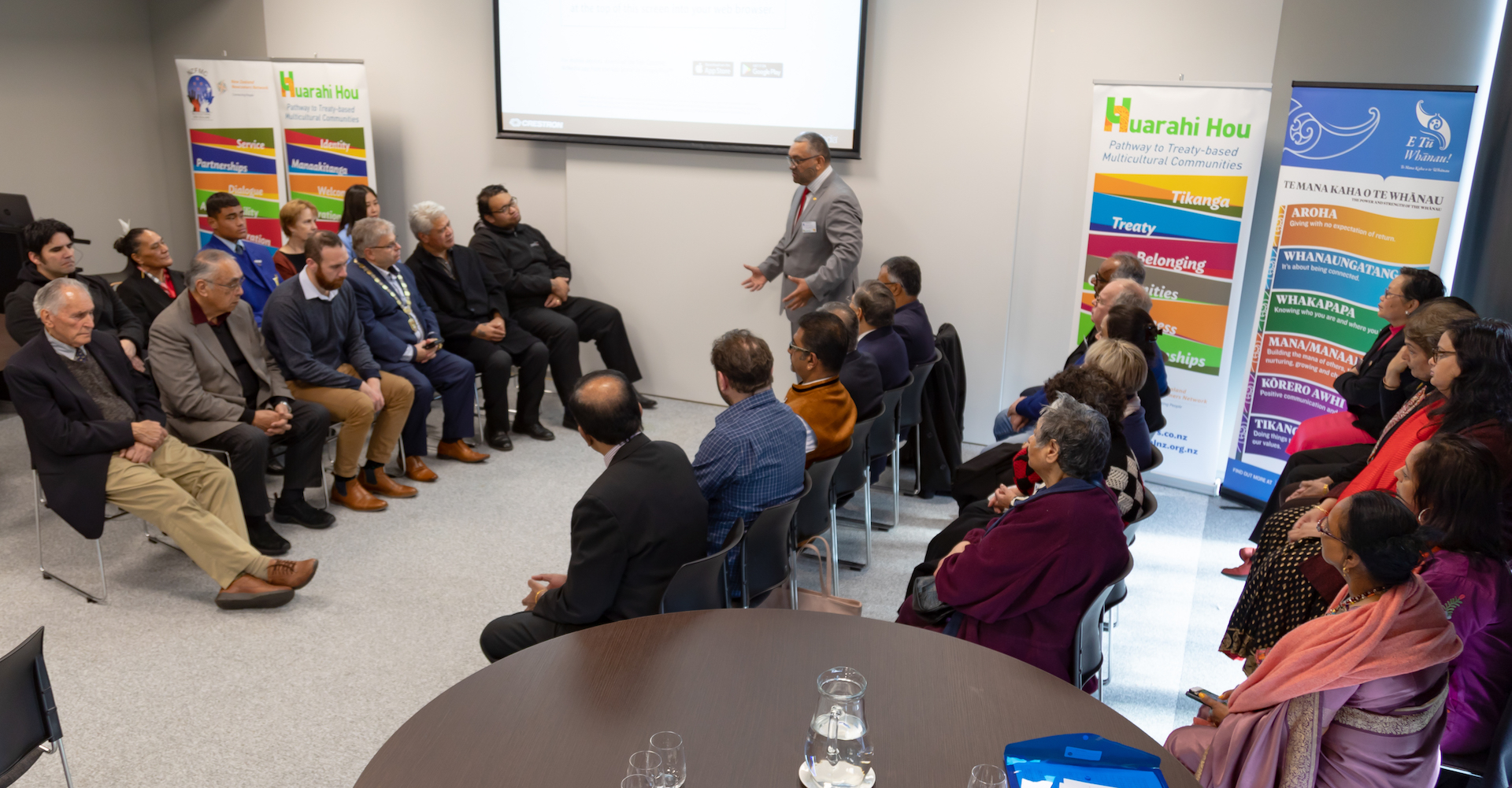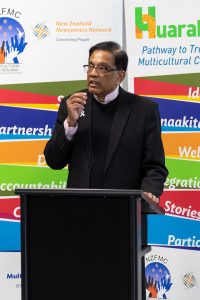Multicultural New Zealand is adamant that intercultural connection between newcomers and tangata whenua is vital to the successful settlement of migrant whānau in their new home.

A powhiri set the scene for this year’s national conference of the Multicultural Council of NZ held in Lower Hutt
Representatives of regional Multicultural Councils throughout Aotearoa embraced ‘Huarahi Hou’, a strategy highlighting the rich relationships between Māori and new migrants when they gathered in Awakairangi (Lower Hutt) in June 2019.
Building a treaty based, multicultural Aotearoa, gratitude for manakitanga shown to newcomers and a strong desire to promote te reo, were common threads in the wide ranging kōrero between local iwi and around 80 men and women from at least 60 different ethnic communities.
We are all someone’s grandchild
Kaumātua of Te Runanganui o Te Atiawa, Dr Kara Puketapu, told the multicultural whānau that, like Māori, they are all mokopuna.
“We are all someone’s grandchild. That’s what Māori call whakapapa,” he said.
“What interests us as Māori, is your culture. You all come from different countries with different cultures and that’s what we want because the world we leave for our grandchildren and grandchildren will be a joined-up community made up of all the peoples of the world, not just New Zealanders.”
Dr Puketapu and the National President of Multicultural New Zealand, Pancha Narayanan, have spearheaded the development of Multicultural New Zealand’s ground-breaking ‘Huarahi Hou’ framework.
Te Tiriti and migrant communities
‘Huarahi Hou’ is a pathway for migrant communities to raise awareness of the Treaty of Waitangi and contemporary Māori culture among ethnic communities. It talks about cultivating strong, ongoing relationships with their local tangata whenua, stimulating curiosity about each other’s lives through formal, and informal marae visits, and creating opportunities for all kinds of artistic and cultural exchanges.
For Pancha Narayanan, a Malaysian with South Indian heritage who migrated to New Zealand with his Chinese-Malaysian wife Pohswan in the mid 80’s, it began as a personal journey.
“My own hikoi started by asking what it means to be a true New Zealander. I felt that the accepted view that we were living in a western European type society, rather than a treaty based Pacific country, was a poor reflection of who we really are. It turned out that a lot of other migrants felt the same.”
“The more I learnt about Māori culture, the more similarities I found with my own, especially the way traditional pre-colonisation Māori put women at the centre of everything.”
“E Tū Whānau, which has been a strong supporter of Multicultural NZ, also emphasises the importance of traditional Māori views on the safety of women and children. That link with E Tū Whānau offered me another way to build my knowledge and sense of connection to Māori values.”
Be the change
Embracing the principle that if you want to see the change, be the change yourself, Pancha and other members of his local Upper Hutt Multicultural Council educated themselves about Te Tiriti o Waitangi and the bi-cultural history of Aotearoa. They knew that it was important to build a genuine relationship with iwi in their own rohe.
“Dr Puketapu welcomed us in a big way and Te Atiawa ki Taranaki were so generous with their time and knowledge. We are working together to find out what a genuine, Treaty-based multicultural framework to help migrants settle well in Aotearoa, would look like.”
In 2012, Multicultural New Zealand and tangata whenua in five regions across the country offered migrants the chance to experience noho on local marae. Feedback was overwhelmingly positive, and the experience was repeated in other parts of the country. Kōrero and engagement, both formal and informal, continued until ‘’Huarahi Hou: Pathway to Treaty-based Multicultural Communities’ was formally evaluated, written up and launched in June 2018.
A sense of belonging through connection
In the introduction to the report, Huarahi Hou is described as ‘a community-led initiative founded on the strong belief that cultural contact between migrants and the receiving community will smooth the path to successful settlement [and help migrants to develop] a sense of belonging in Aotearoa New Zealand.’
The delegates from around Aotearoa who gathered in Awakairangi for the Multicultural New Zealand Huarahi Hou hui were energised and inspired by Huarahi Hou. They were clear that it was up to them to take action to ensure migrants are exposed to te reo and Te Ao Māori and that they build strong friendships with Māori whānau.
Their vision is like Dr Puketapu’s. They see themselves living in Aotearoa, a Pacific country built by people from all over the world that they, their children, and their mokopuna call home.

